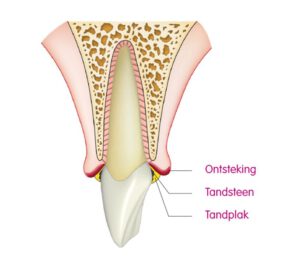Gingivitis
Inflammation occurs in response to the presence of plaque and tartar on the teeth. The inflammation that is (still) very superficial at the edge of the gums is called gingivitis. This inflammatory reaction causes the gums to become red, swell and bleed easily when touched. The space between the teeth / molars and the gums, the pocket which is normally no deeper than 3 mm, can become deeper due to the inflammation. This pocket deepens in gingivitis due to the swelling of the gums and the gums become more slack, making the protection of the gums increasingly ineffective.

The phenomena
The trouble with gingivitis is that you can't always diagnose it yourself. Inflamed gums can be red, flabby and swollen. It can also bleed when brushing or eating. But it doesn't have to be. These phenomena are not always present. So if your gums don't bleed when brushing or eating, it doesn't mean your gums are healthy. That is why a regular visit to the dentist and/or dental hygienist is so important: they can determine whether or not you suffer from gingivitis.
Detecting gingivitis
The dentist and/or dental hygienist can detect gingivitis with a so-called pocket probe. The pocket probe is used to carefully scan the space between the tooth and gums (the pocket). If the pocket has deepened or if bleeding occurs during the measurement, the gums are inflamed. You can then make an appointment with your dentist and/or dental hygienist to have your teeth cleaned and, where necessary, made smoother or smoother. When you then keep your teeth optimally clean, the inflammation will disappear and the gums will lie tighter around your teeth, the pocket will become shallower than 3 mm again and the bleeding will stop. Therefore, make sure that you have your teeth checked regularly. This will prevent any existing gingivitis from worsening or coming back.
Preventing gingivitis
What can you do yourself to prevent gingivitis? The answer to that question is: keep your mouth as clean as possible, ensure that the plaque does not get a chance. The dentist and/or dental hygienist can explain how best to remove dental plaque using an (electric) toothbrush and toothpicks or brushes. Good oral hygiene is the foundation!
You cannot remove tartar yourself, you have to go to the dentist and/or dental hygienist for this. Good daily oral hygiene, if necessary combined with the removal of tartar and smoothing of the tooth surfaces by the dentist and/or dental hygienist, will normally clear up gingivitis within a few days. If you keep your mouth clean every day, you can prevent gingivitis from developing again.
Source: NVvP
Come visit us!
- info@mondzorg-valerius.nl
- +31 0 70 870 1466
- Valeriusstraat 25, 2517 HM The Hague